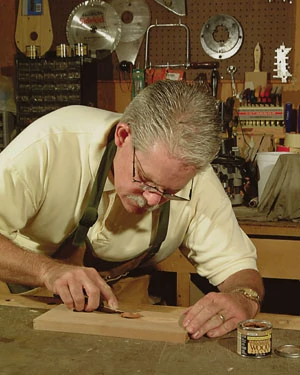If your motto is “repair, not replace,” good wood filler should have a place of honor in your supply closet. It is indispensable for restoring damaged areas in wood to like-new condition and for filling wood grain so that woodwork or furniture will take stain evenly.
Wood filler, a.k.a. wood putty or wood patch, typically comes in two varieties – water-based and solvent-based.
Solvent-based filler has long been the industry mainstay, a dependable product for both the professional woodworker and the do-it-yourselfer. However, advances in water-based wood filler technology have resulted in a product that performs as well as solvent-based filler. Plus, water-based filler has little or no impact on the environment, is free from solvent fumes and easy to handle.
Where water-based filler truly shines is in its easy clean-up. No acetone or turpentine is required, just water. Since water-based filler won’t dry out in the can as easily as solvent-based, you’ll find good putty the next time you need wood filler. Perhaps most important is that do-it-yourselfers do not sacrifice adhesion quality by choosing water-based filler.
“In fact,” says Bob Mack, chemist for Famowood professional wood fillers, “Choosing a wood filler to add to your home repair kit is a matter of personal preference since both water- and solvent-based are terrific for preparing unfinished wood for staining and for filling holes and cracks in woodwork and furniture around the house.”
How to Choose a Wood Filler
All wood fillers, whether solvent- or water-based, are not equal. Look for good adhesion. Good filler will not shrink when dry or pop out of repairs. When cured, good filler sands with minimal effort to a satiny finish.
Wood filler is great for evening out the grain in large-pored or open-grained hardwoods like oak, ash, poplar, rosewood, hickory and walnut. These hardwoods absorb wood stains and varnishes unevenly because the pores tend to suck up the finish, while the rest of the surface does not.
Using wood filler prior to staining helps achieve a smooth, even surface by filling the pores and thus minimizing the appearance of grain lines. (If you are doing a hardwood floor or other large surface, Mack recommends that you use a trowel-grade grain filler, which is somewhat thinner in consistency and therefore easier to apply.)
Whatever kind of wood you are working on, you can achieve different finish effects depending on the filler color you choose. To emphasize the grain, select a filler color that contrasts with the natural color of the wood or the color of the final stain. To de-emphasize the wood grain, use a color that closely matches the final finish you want.
However, it’s important to check for “grain rise” on an inconspicuous area of the wood when using filler, especially one thinned with water.
“Wood is designed to move water,” Mack explains. “So when you have water in the product, it can move into the grain, raising it.” According to Mack, the problem usually is minimal, but if it does occur, solvent-based fillers are the better solution.
For the Best Result:
Test your entire process – Before tackling that expensive table top, practice on a piece of scrap wood by sealing, filling, sanding and top-coating it. Doing so will save you a lot of frustration and disappointment, and ensure you get the result you want.
Have more than one color on hand – If you are trying to match the wood closely, having a variety of colors available allows you to mix up just the right shade to repair that ding in the buffet table. Water-based and solvent-based filler are both easy to mix. Solvent-based filler sometimes provides a larger color selection for those hard-to-match pieces.
Match the product to the job – Water-based filler’s “buttery” consistency means better adhesion on contact than its solvent-based cousin can provide; you don’t need to pack water-based filler into the damaged area as firmly, so the filler can be laid into defects more easily.
However, water-based putty may tend to dry slower in deeper defects where it can “skin over” and not allow the water to evaporate as well as solvent-based filler. You can avoid this problem by using solvent-based filler or by applying more than one shallow application of filler and letting each layer cure before applying the next. This technique also helps avoid shrinkage and cracking of the putty. In most cases, both types of filler have about the same drying time.
Also, consider the location of your project when deciding which type of filler to use. If your repair is outdoors, you may want to use solvent-based filler. “Water-based filler may freeze,” Mack offers. “Good water-based filler has tested well in extreme temperatures, but an outdoor bench or deck railing repair is more susceptible to the elements.” If the object is subjected to repeated freezing and thawing, performance eventually may be affected.
Each type of filler has its benefits. Keep in mind drying time, temperature and clean-up options when making your choice. Save money by doing your own repairs on damaged wood trim and furniture. It’s never been easier with the quality wood fillers on the market.
Editor’s Note: For answers to technical questions about how to use wood fillers, call the Famowood help line at 1-800-349-4667 or visit online at www.eclecticproducts.com.




